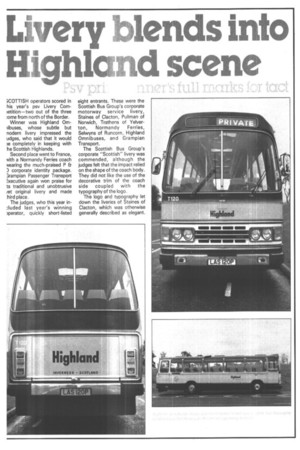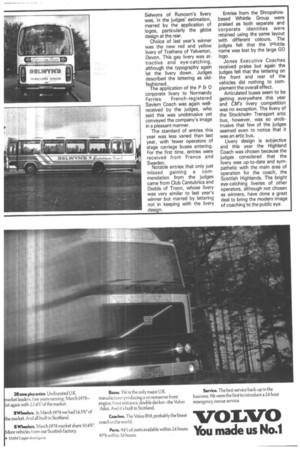Livery blends into Highland scene
Page 51

Page 53

If you've noticed an error in this article please click here to report it so we can fix it.
;COTTISH operators scored in his year's psv Livery Cornpetition—two out of the three :ome from north of the Border. Winner was Highland Omlibuses, whose subtle but nodern livery impressed the udges, who said that it would )e completely in keeping with he Scottish Highlands.
Second place went to France, vith a Normandy Ferries coach gearing the much-praised P Et ) corporate identity package. 3rampian Passenger Transport Executive again won praise for ts traditional and unobtrusive fet original livery and made hird place.
The judges, who this year in;Iuded last year's winning )perator, quickly short-listed eight entrants. These were the Scottish Bus Group's corporate motorway service livery, Staines of Clacton, Pullman of Norwich, Trathens of Yelverton, Normandy Ferries, Selwyns of Runcorn, Highland Omnibuses, and Grampian Transport.
The Scottish Bus Group's corporate "Scottish" livery was commended, although the judges felt that the impact relied on the shape of the coach body. They did not like the use of the decorative trim of the coach side coupled with the typography of the logo.
The logo and typography let down the liveries of Staines of Clacton, which was otherwise generally described as elegant. Selwyns of Runcorn's livery was, in the judges' estimation, marred by the application of logos, particularly the globe design at the rear.
Choice of last year's winner was the new red and yellow livery of Trathens of Yelverton, Devon. This gay livery was attractive and eye-catching, although the typography again let the livery down. Judges described the lettering as oldfashioned.
The application of the P 80 corporate livery to Normandy Ferries French-registered Saviem Coach was again wellreceived by the judges, who said this was unobtrusive yet conveyed the company's image in a pleasant manner.
The standard of entries this year was less varied than last year, with fewer operators of stage carriage buses entering. For the first time, entries were received from France and Sweden.
Notable entries that only -just missed gaining a commendation from the judges came from Club Cantubrica and Dodds of Troon, whose livery was very similar to last year's winner but marred by lettering not in keeping with the livery design.
Entries from the Shropshirebased Whittle Group were praised as both separate and corporate identities were retained using the same layout with different colours. The judges felt that the Whittle name was lost by the large GO logo.
Jones Executive Coaches received praise but again the judges felt that the lettering on the front and rear of the vehicles did nothing to complement the overall effect.
Articulated buses seem to be getting everywhere this year and CM'S livery competition was no exception. The livery of the Stockholm Transport artic bus, however, was so unobtrusive that few of the judges seemed even to notice that it was an artic bus.
Livery design is subjective and this year the Highland Coach was chosen because the judges considered that the livery was up-to-date and sympathetic with the main area of operation for the coach, the Scottish Highlands. The bright eye-catching liveries of other operators, although not chosen as winners, have done a great deal to bring the modern image of coaching to the public eye.


































































































































